Deptford: The London high street voted one of the world's coolest
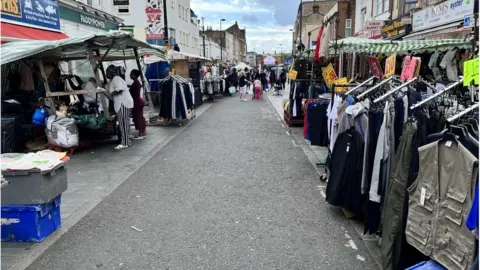 BBC
BBCDeptford High Street in the borough of Lewisham, south-east London, has been named one of the 33 coolest streets in the world, following a vote by Time Out magazine.
Ranking the area alongside roads in San Francisco, Bangkok and Mexico City, it was described by the magazine as "the most alive street in London".
So what do local residents think makes it such a great place to be? And what does the future look like as the cost-of-living crisis takes hold and high-end developments continue to spring up in the area?
Exiting the modern Deptford railway station, a varied but culturally rich row of stores appear, with eye-catching tattoo parlours, quirky coffee shops and vibrant hairdressers.
Surrounding the high street is a blend of modern and traditional, as reflected by the housing with high-rise apartment buildings looking down upon traditional Victorian houses.
"There is a massive mix of cultures in Deptford," says Jamie O'Flynn, the managing director of Mouse Tail Coffee, situated in the arches underneath the railway station.
"It seems quite harmonious, everyone seems to get on - it is a very friendly part of London.
"There's a lot more restaurants and bars than 10 years ago, a lot more things to do on the high street. But at the end of the day, it's still the same high street as it was 10 years ago, there's still that integrity to it."
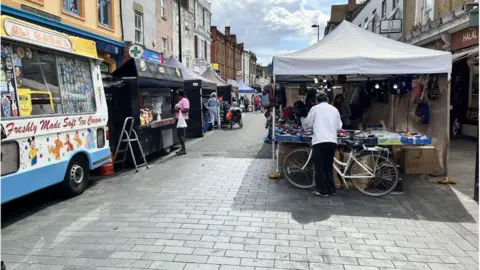
It is a busy market day, and the sounds of hundreds of conversations are only overpowered by a speaker blasting out Soca music. The air is also heavy with a strong scent of Caribbean cuisine.
"It (Deptford) has definitely come a long way," believes Alec, the owner of The Waiting Room coffee shop.
"There was not a great deal to do in the evenings, there were a few pubs, but now you have got so many different bars, clubs, restaurants and more social spaces to hang out.
"It has changed massively in the last six years, and before then there were things to do, but it was not on the level of things now."
Despite the buzz on the high street as people dart between the stalls looking for bargains, there is concern among many as autumn beckons.
Inflation is expected to hit 18% next year and as bills continue to rise sharply, some businesses are fearing for their survival.
"It is a very worrying point with the escalating utility costs," adds Alec.
"With businesses having to find £2,000-£3,000 extra a month and utility prices raising higher than rent - it is kind of absurd.
"We sadly saw a lot of local residents being outpriced a few years ago and now it is a very similar thing - what is bringing people into the area if it is not there anymore?"
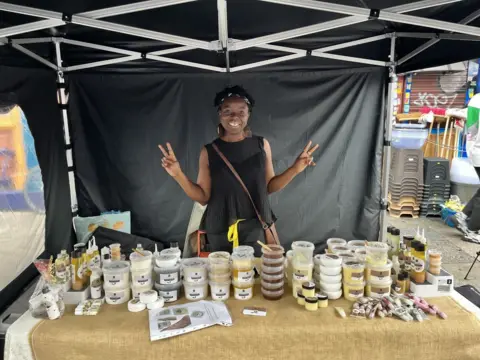
Yet not all hold these fears and a sense of optimism lingers around parts of the high street.
"We are going to power through anyway, I like the resilience of people around here," says Ola, who works at a skincare market stall.
"We are going to be here, come rain or shine, we are just going to carry on.
"There are concerns, but we just have the faith we are going to power through."
A short walk from the high street marks another clash between new and old, as the DLR soars above the old terraced housing below.
It is on this side where local charity shop and food bank Kath's Place can be found, run by long-time Deptford resident Ray Woolford.
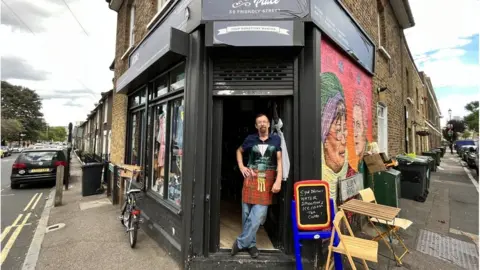
He considers the area, which for centuries was a centre of shipbuilding in the capital, "one of the most important places in Britain for history and heritage, but it has never been celebrated".
"Deptford is creative, it's artistic, it buzzes, it's got a lovely sense of values.
"And yet the problem is all those wonderful things that make this a great place to live are what developers come along and try and hijack as a way of selling their luxury developments."
The emergence of high-end homes in the area means that Deptford is losing its sense of identity, Mr Woolford believes.
The median weekly wage in Lewisham borough, where Deptford is situated, was £575 last year - lower than the £652 average across London's inner boroughs as a whole, according to the Office for National Statistics (ONS).
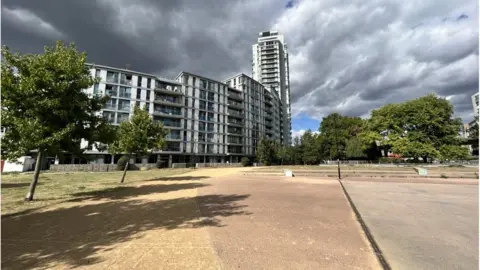
"When you take away local affordable housing, like council housing, you end up in a crazy scenario where that sense of community is lost," says Mr Woolford.
"The artists get priced out, the elderly do not have their children around to look after them, there are no grandchildren to bring back to bring back life into the eyes of the elderly.
"You end up cleansing Deptford High Street."
Mr Woolford adds that "the people that live on these luxury developments often will not use Deptford High Street, they will get a train to the West End or they use online services."
"The actual illusion that thousands of people who move into Deptford use local shops is a fallacy," he says.
"Most people will say business is in decline, so its not right that gentrification brings improvement."
However, not everyone is worried about these new developments which rise up above the skyline.
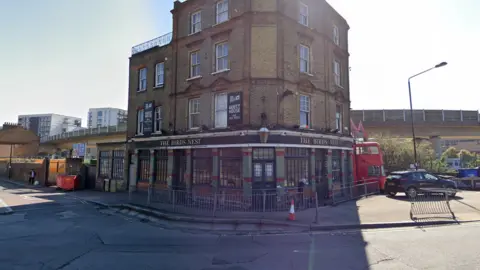 Google
Google"It is quite a real part of London," says Joel Matthews, landlord of The Bird's Nest pub, which is situated just off the high street.
"There are quite a lot of flats here, but I feel like they are being added to what is already here - you do not see many things being demolished.
"A lot of the people who have lived here a long time are still living here, they are not moving out, it is just more people coming to the place."
The pub is set to be expanded in the coming months after proposals submitted by developers saved the pub, according to Mr Matthews.
"As a business owner, we do need more residents here," he adds.
"As long as people are not being forced out or pushed away, I do not think there is gentrification, just things are being added."

Follow BBC London on Facebook, Twitter and Instagram. Send your story ideas to [email protected]
